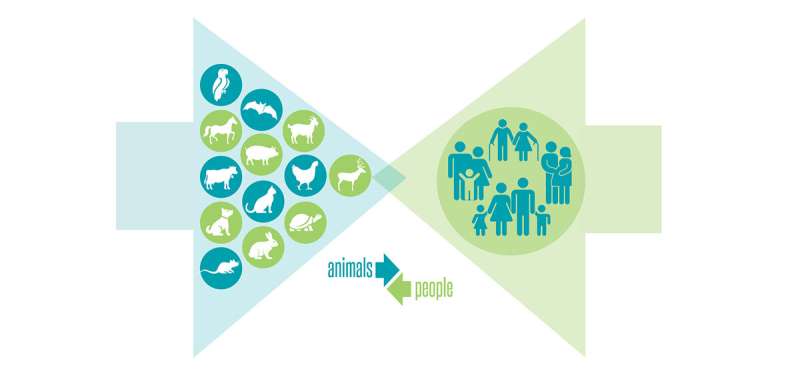What causes disease outbreaks?

Since 1974, contaminated water has been the most common driver of large-scale zoonotic infectious disease outbreaks, according to new research from the Center for the Ecology of Infectious Diseases (CEID) at the University of Georgia. The next two greatest drivers are unusual weather patterns and changes in the abundance of disease vectors such as mosquitos and ticks.
Zoonotic diseases occur when pathogens are transmitted from animals to humans—prominent recent outbreaks include Ebola hemorrhagic fever and COVID-19. However, most zoonotic disease outbreaks involve fewer than 100 cases and are quickly brought under control. So what factors drive large-scale outbreaks?
In a study published in the Philosophical Transactions of the Royal Society B: Biological Sciences, researchers investigated over 4,400 zoonotic infectious disease outbreaks. They identified the 100 largest in terms of numbers of human cases, all of which infected thousands to hundreds of thousands of people. From the full list they also selected 200 outbreaks at random to serve as “case controls.” The majority of these control outbreaks included 43 or fewer cases. They then compared the characteristics of large-scale and control outbreaks, particularly how the primary causes of infection and disease spread varied between them.
Lead author Patrick Stephens, an associate research scientist with the Odum School of Ecology and CEID, said that this research is one of the first peer-reviewed studies to quantify the variation of infectious disease outbreak drivers across the globe.
“In the age of COVID-19, it is understandable that many people may not realize how many outbreaks of other infectious diseases are caused by complex, intertwined ecological and socioeconomic conditions,” he said. “We know that factors like exposure to wild mammals, habitat disruption, international trade and travel and contact with contaminated food and water are important considerations. Our research was designed to understand what proportion of outbreaks various drivers contributed to. To our knowledge, this study is the first to do so for a global sample of outbreaks of many diseases.”
Stephens worked with CEID researchers Nicole Gottdenker of the College of Veterinary Medicine and John Drake, Annakate Schatz and John Paul Schmidt of the Odum School to compile a list of contemporary zoonotic infectious diseases documented in peer reviewed scientific literature. They identified and scored 48 specific infectious disease drivers related to the large-scale and control outbreaks in ecological, environmental and socioeconomic categories.
Water contamination is a key driver of disease outbreaks
Both large-scale and control outbreaks were associated with water contamination, which was the most common driver of large outbreaks and the second most common driver of the smaller control outbreaks. Examples of these water-associated diseases include hepatitis E, typhoid and shigellosis (dysentery). The remaining drivers differed, however.
In addition to water contamination, large outbreaks were most often associated with unusual weather patterns, changes in the abundance of vectors—carriers of disease like mosquitos or ticks—and sewage management.
Large outbreaks were also much more likely to be caused by viral pathogens such as SARS coronavirus, influenza virus and Japanese encephalitis virus than were smaller outbreaks. The typical smaller outbreaks were associated with food contamination, local livestock production and human-animal contact. Finally, individual large outbreaks tended to be driven by a greater variety of factors than control outbreaks.
“There is still a lot of work to do to understand how large-scale infectious disease outbreaks can be avoided and controlled,” Stephens said. “Perhaps two-thirds of future infectious disease outbreaks are expected to be caused by zoonotic pathogens, and the number of these diseases is growing worldwide. Our research is an extremely important first step to better understand global variation in the drivers of outbreaks.”
Patrick R. Stephens et al, Characteristics of the 100 largest modern zoonotic disease outbreaks, Philosophical Transactions of the Royal Society B: Biological Sciences (2021). DOI: 10.1098/rstb.2020.0535
Citation:
What causes disease outbreaks? (2021, October 26)
retrieved 26 October 2021
from https://phys.org/news/2021-10-disease-outbreaks.html
This document is subject to copyright. Apart from any fair dealing for the purpose of private study or research, no
part may be reproduced without the written permission. The content is provided for information purposes only.
For all the latest Science News Click Here
For the latest news and updates, follow us on Google News.

